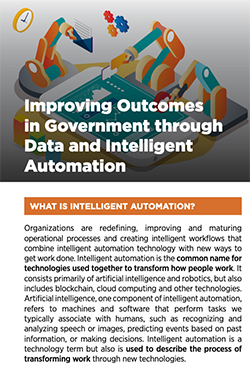
Improving Outcomes in Government through Data and Intelligent Automation

It can help employees quickly analyze data by reading and interpreting information on documents faster than people can.
The IBM Center for The Business of Government and the Partnership for Public Service conducted a series of webinars with government leaders to discuss how they are using these technologies to improve both how they work internally and how they provide services externally. These sessions highlighted real cases and lessons learned that can help all agencies understand how best to apply emerging technologies.
Agencies interested in adopting intelligent automation tools should consider the following steps:
- Identify the problem you are trying to solve. Intelligent automation technologies are most effective when used to address a specific problem.
- Determine whether intelligent automation is the right tool for the problem. Intelligent automation tools should only be used if they are the most effective solution to a problem.
- Identify what data you already have. Intelligent automation tools depend on data and are only as good as the data they use.
- Speak with other federal agencies working to solve similar problems. Many agencies are already using intelligent automation tools to solve problems, and they could share with new users the valuable lessons they learned. For example, government employees can join the General Services Administration’s artificial intelligence community of practice by emailing AI-subscribe-request@listserv.gsa.gov.
This final report summarizes the five virtual panels we conducted in 2020 on IA, AI, and Blockchain. The sessions highlighted real cases and lessons learned that can help all agencies understand how best to apply emerging technologies. Watch a replay of the panel event and view an artistic interpretation of the event.
To learn more about the five virtual panels, read our summary blogs and watch the webinar replays.
- Successful Adoption of IA in Government: The Case of the Marine Corps - (Webinar)
- Successful Adoption of IA in Government: The Case of the DHS Procurement Innovation Lab - (Webinar)
- Successful Adoption of IA in Government: Insights from HHS’ ReImagine Grants Initiative - (Webinar)
- Driving Data With Emerging Technologies: Insights from GSA and DOD - (Webinar)
- Driving Data With Emerging Technologies: Lessons from Disaster Management and Response Efforts at the Departments of Defense and Energy - (Webinar)
Read the article, "Disparate agencies encountering similar lessons, pitfalls in prioritizing AI efforts" in Federal News Network
Read the article about the report, "The Future of AI and Intelligent Automation at Agencies" in FedTech Magazine.



